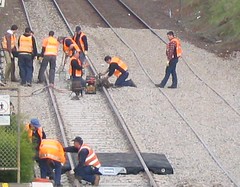Originally posted at Transport Textbook.com and (in abridged form) in the PTUA Newsletter.
 Ever since the Victorian Transport Plan last December flagged that the South Morang rail extension would finally be built, there has been speculation as to why the cost was so high. At $650 million for a 3.5 kilometre extension, many pondered if it would include gold-plated rails and platforms.
Ever since the Victorian Transport Plan last December flagged that the South Morang rail extension would finally be built, there has been speculation as to why the cost was so high. At $650 million for a 3.5 kilometre extension, many pondered if it would include gold-plated rails and platforms.
When the 2009 state budget actually committed funding to it, the price had dropped slightly to $562 million, but this was due to the initial figure including running costs, apparently for several decades. Even counting the duplication from Keon Park to Epping at the same cost as the extension, it was still five times higher than the per-kilometre cost of the Craigieburn project completed just two years ago.
A feature article in The Age in June highlighted the issue, with local activists delighted at the commitment but mystified over the price, the opposition claiming taxpayers are being dudded, and public transport advocates (such as myself) fearing that the high price will discourage governments from future rail extensions. The Department of Transport offered the explanation that the project was a “more holistic approach to scoping the expansion of the Epping line”, but apparently didn’t clarify this in any great detail.
We (the PTUA) subsequently met with the Department, and finally discovered the real truth behind the term “holistic”. It turns out the scope of work is much bigger than just the South Morang extension plus duplication from Keon Park.
The way it was described, it includes:
- Keon Park to Epping
- duplication, obviously including track and overhead
- two or three pedestrian grade-separations
- station upgrades, and an additional platform at Thomastown
- upgrades to 4 level crossings to latest standard
- resignalling, including removal of bidirectional signalling on the existing single track (it conflicts with the proposed location of the second track), and re-signalling most of the rest of the line, almost down to Clifton Hill
- stabling at Epping, with driver facilities to enable future changeovers to move away from Flinders St
- extra substations
- Epping to South Morang
- dual track, overhead. We were told the old alignment can’t be used without modification, as there are grade separations and other issues with it
- signalling
- Dalton Road grade separation. Due to proximity of Epping train maintenance facilities (which can’t be moved), relocation of local roads (which can’t be disconnected from Dalton Rd) and the nearest creek (which the track must get over), this is said to be a reasonably complicated component, on a similar scale to Springvale Road grade separation
- 3 bridges over creeks
- bike/ped path along rail route, and included in bridges
- grade separation of Pindari Avenue and Civic Drive
- a new substation
- communications systems including radio towers
- South Morang station, including bike, bus, car parking, and provision for further extension to Mernda
- Hurstbridge line
- signalling upgrades on parts of line, to help harmonise frequencies to work better with the Epping/South Morang line
- stabling at Eltham, including driver facilities, and which will require the moving of some existing trackwork
The scope of works goes some way to explaining the cost. Perhaps it doesn’t bring it down to the level of Perth’s Mandurah line, but at the very least it brings it back down to somewhere near Planet Earth.
It seems to makes some sense to include in the project scope upgrades that will help the rest of the Clifton Hill group run better. If things turn out to plan, in 2013 (just in time for the 2014 state election) the benefits should be felt not just to residents in South Morang, but also elsewhere along the Epping and Hurstbridge lines.
What is a real mystery is why the Department doesn’t publicise the true scope of the project. While the information is apparently no secret, as a number of groups have been briefed on the project breakdown, neither has it been made public.
Surely flagging the real scope of the project, with all the resultant benefits, would be better for the government than hiding the details away and having major newspapers writing feature articles highlighting the apparent cost overruns and implying incompetent project management.

